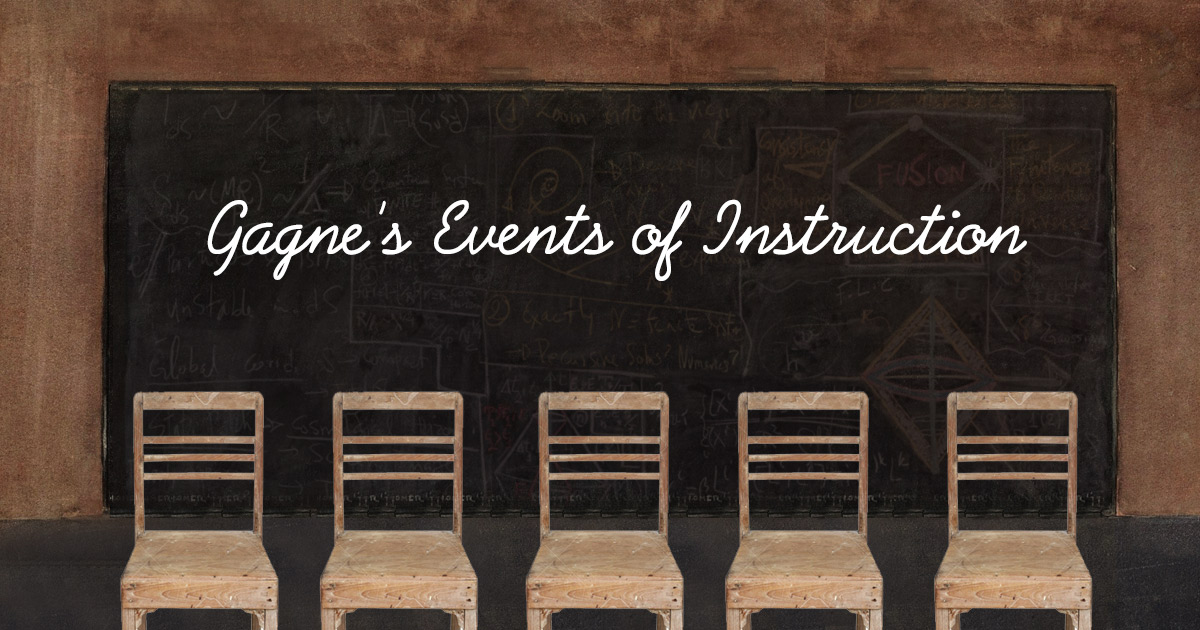
“Direct Instruction is used to describe learning material in which the teacher or expert transmits information directly to learners structuring learning time to reach a clearly defined set of objectives as efficiently as possible.”
Rooted in behavioral and cognitive theories, this approach propounds that concepts, principles, and ideas be presented in an organized manner in order to facilitate learning. It works well with novice learners, when the primary objective is the learners’ mastery of standardized facts, concepts, rules or procedures.
Gagne’s Events of Instruction is a framework that can be used for Direct Instruction.
According to Gagne, a learning unit (lesson/topic/module) should include nine learning events. The nine events are based on the manner in which our brain processes information. It is especially useful when you start off as an instructional designer. It is also valuable in training organizations that operate in the factory mode and produce learning material in high volumes.
Given below is an example of how you can use this framework. This is an example of a module on how to design the content outline for a lesson, given our working memory limitations. The concept of Goldilocks of the Brain is used to explain working memory limitations and the need to consider cognitive load in lesson planning. (Note: The term Goldilocks of the Brain was coined by Amy Arnsten, Professor of Neuroscience at Yale School of Medicine.)

This framework is flexible – you may reorder the events or even drop one or two. It is well-researched and time-tested, and it even has the four components of Keller’s motivational design built into it. It is important to note that Gagne’s Events of Instruction is not a rigid tool, but a guideline – you may drop an event or two, and even re-order events if required.
Significance of Gagne’s Events
Gagne’s Events of instruction is a pattern that works most of the time, regardless of the delivery media. However, personally I have found that there are some situations when it does not work very well, especially in learning programs that are designed for adults. Why so? Well, do you recall Andragogy or Adult Learning principles? Remember the principle according to which, adults like to be given the opportunity to use their existing foundation of knowledge and apply their experiences in learning? Most adults welcome opportunities to share their interests and experiences and appreciate reflective learning. Gagne’s Events doesn’t take this into account.
So, in what situations is this framework recommended, and not recommended? From my experience I have found that it works well in the following situations:
Universally Accepted Principles: Gagne’s Framework works well in situations when very specific knowledge that is universally accepted needs to be imparted to ensure a uniform understanding. This includes content, which addresses basic scientific principles that are universally accepted or any content that is a derivative of these principles. Some examples are: Some examples are: Universal Laws of Gravitation, Newton’s Laws of Motion, Laws of Thermodynamics, and Economic Principles, such as Demand and Supply.
Content with a high intrinsic cognitive load: This framework also works well in situations which require the explanation of complex content – content that has an intrinsic cognitive load; and is difficult to understand by novices, beginners and intermediate learners (even though they are youth/adult learners). For example, in K-12 learning, physics and mathematics have a high intrinsic cognitive load as compared to social sciences and humanities. Similarly, in corporate training, how refrigerant chillers work will have a higher cognitive load as compared to leadership principles.
And I have found that the framework doesn’t work well in the following situations:
Principles that are derived: Situations when the content is a derivative of what people have experienced, perhaps successfully. Basically, the content cannot be accepted as universal law, and there may or may not be consensus around it since it is derived from people’s experiences.
Content with a low intrinsic cognitive load: This framework is not recommended in situations which require the explanation of simple content for adult and youth learners – content that does not have an intrinsic cognitive load. It is easy to comprehend even by novices, beginners and intermediate learners. For example, Time Management, Team Building and so on.
So, the next time you think of using Direct Instruction, go ahead and do it. It may not be the flavor of the month, but it is definitely useful in many situations. And by applying Gagne’s Events, you can ensure that your teaching methodology is effective.
Here are some articles that debunk the myth about Direct Instruction.

0 responses on "Gagne's Events of Instruction"